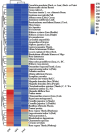Comprehensive Analysis of 50 Edible Flowers From Yunnan Province: Active Components, Antioxidant Capacity, Tyrosinase Inhibition, and Antimicrobial Activity
- PMID: 40697708
- PMCID: PMC12279552
- DOI: 10.1002/fsn3.70666
Comprehensive Analysis of 50 Edible Flowers From Yunnan Province: Active Components, Antioxidant Capacity, Tyrosinase Inhibition, and Antimicrobial Activity
Abstract
Edible flowers are widely consumed for their potential health benefits. This study assessed the active components and in vitro antioxidant properties of 50 edible flowers from Yunnan to explore their potential uses. A 70% ethanol extract was prepared, and the total polyphenol content (TPC), total flavonoid content (TFC), and total anthocyanin content (TAC) were analyzed. Antioxidant capacity was evaluated using the ferric reducing antioxidant power (FRAP), 2,2-diphenyl-1-picrylhydrazyl (DPPH), and 2,2'-azino-bis(3-ethylbenzothiazoline-6-sulfonic acid) diammonium salt (ABTS) assays. Additionally, tyrosinase inhibition and antimicrobial activities were determined, and the correlation between active components and antioxidant capacity was investigated. The results showed that Prunus mume had high polyphenol content, Osmanthus fragrans Lour. had high flavonoid content, and Rosa rugosa Thunb. (Dianhong) had high anthocyanin content. Rosa rugosa Thunb. (Mohong) exhibited the strongest DPPH and ABTS radical scavenging activities. Clerodendranthus spicatus (Thunb.) C. Y. Wu demonstrated the highest FRAP activity, whereas Punica granatum L. showed the highest tyrosinase inhibition activity. Nymphaea coerulea exhibited significant antimicrobial effects against Escherichia coli and Staphylococcus aureus. Extracts from Hibiscus rosa-sinensis and Platycodon grandiflorus (Jacq.) A. DC. demonstrated excellent antimicrobial effects against Pseudomonas aeruginosa. Correlation analysis indicated a positive relationship between TPC and antioxidant activities, suggesting that polyphenols are closely linked to antioxidant capacity. This study highlights the potential of these edible flowers as antimicrobial agents and natural antioxidants. Analysis using the membership function identified N. coerulea, R. rugosa, P. granatum, and Lagerstroemia indica L. as having the highest comprehensive scores, indicating their superior quality as sources of bioactive compounds.
Keywords: anthocyanin; antimicrobial activity; antioxidant capacity; edible flowers; flavonoid; polyphenol; tyrosinase inhibition.
© 2025 The Author(s). Food Science & Nutrition published by Wiley Periodicals LLC.
Conflict of interest statement
The authors declare no conflicts of interest.
Figures







Similar articles
-
Influence of edible flower inclusion on the nutritional and flavor changes of fermented pear wine.Front Nutr. 2025 Jul 21;12:1604754. doi: 10.3389/fnut.2025.1604754. eCollection 2025. Front Nutr. 2025. PMID: 40761353 Free PMC article.
-
Metabolite Profiling of Clerodendranthus spicatus by UHPLC-Q-Orbitrap HRMS and Evaluation of Antioxidant and Tyrosinase Activation Activities.Chem Biodivers. 2025 Jul 28:e00156. doi: 10.1002/cbdv.202500156. Online ahead of print. Chem Biodivers. 2025. PMID: 40720617
-
Solvent Fractionation of Polygonum cuspidatum Sieb. et Zucc. for Antioxidant, Biological Activity, and Chromatographic Characterization.Int J Mol Sci. 2025 Jul 21;26(14):7011. doi: 10.3390/ijms26147011. Int J Mol Sci. 2025. PMID: 40725265 Free PMC article.
-
A systematic review on natural products with antimicrobial potential against WHO's priority pathogens.Eur J Med Res. 2025 Jul 1;30(1):525. doi: 10.1186/s40001-025-02717-x. Eur J Med Res. 2025. PMID: 40597250 Free PMC article.
-
Falls prevention interventions for community-dwelling older adults: systematic review and meta-analysis of benefits, harms, and patient values and preferences.Syst Rev. 2024 Nov 26;13(1):289. doi: 10.1186/s13643-024-02681-3. Syst Rev. 2024. PMID: 39593159 Free PMC article.
References
-
- Behbahani, A. B. , Noshad M., Falah F., et al. 2025. “First Report on the Synergy of Nepeta menthoides and Nepeta cephalotes Essential Oils for Antimicrobial and Preservation Applications: A Multi‐Ligand Molecular Docking Simulation.” Applied Food Research 5, no. 1: 100707. 10.1016/j.afres.2025.100707. - DOI
-
- Behbahani, B. , Noshad A. M., Falah F., et al. 2024. “Synergistic Activity of Satureja intermedia and Ducrosia anethifolia Essential Oils and Their Interaction Against Foodborne Pathogens: A Multi‐Ligand Molecular Docking Simulation.” LWT—Food Science and Technology 205: 116487. 10.1016/j.lwt.2024.116487. - DOI
LinkOut - more resources
Full Text Sources
Miscellaneous

